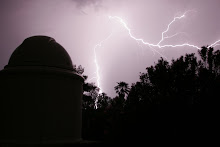Here's an image of two bright nebulae found in the summer constellation of Cygnus, the Swan. NGC7000 is called "The North American Nebula", and IC 5070 is called "The Pelican Nebula". These bright nebula consist primarily of Hydrogen gas (like most of the rest of the Universe), and in this rendition I've mapped the glow from Hydrogen-alpha emission to the green color channel. I also used filters that gathered light from OIII (doubly-ionized oxygen) and SII (singly-ionized sulfer), and mapped that data to blue and red color channels, respectively. This color mapping strategy is known as "The Hubble Pallet" and results in a false-color image; the nebulae shown above would certainly not appear to be green to the naked eye. In "reality", they would appear to us to be reddish, since H-a is the dominant emission and it comes at a wavelength of about 6563 angstroms, which is in the region of the spectrum that our eyes see as "red". Note that the SII data would also be in the red, so it's impossible to create an RGB image from these filters without mapping something as a false color.
Does this diminish the beauty, the true wonder of observing these amazing interstellar objects? Personally I don't think so. Using the color maps allows visual interpretations of the nebulae that might not otherwise be possible. If I were trying to use the data for some critical science application, the colors probably would be irrelevant anyway. When using the data to create a representation of the wonders of our universe, a representation that may stir the soul in ways that words cannot, I think it's acceptable to take some artistic license and work with false colors.
This is my first image with some new 5 nano-meter bandwidth filters, and clearly I could have improved it by simply rotating the camera slightly. Nevertheless, I hope you find a bit of enjoyment in viewing this image. For more information and a higher-resolution version, visit http://www.xanaduobservatory.com/ngc7000.htm.


No comments:
Post a Comment